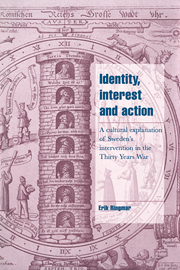 Identity, Interest and Action
Identity, Interest and Action Book contents
- Frontmatter
- Contents
- List of illustrations
- Acknowledgements
- Introduction: the beginning of the story
- Part I A narrative theory of action
- Part II Why did Sweden go to war in 1630?
- 4 Historical and cultural preliminaries
- 5 Fighting for a national interest
- 6 Fighting for a national identity
- Conclusion: the end of the story?
- Notes
- Bibliography
- Index
6 - Fighting for a national identity
Published online by Cambridge University Press: 21 October 2009
- Frontmatter
- Contents
- List of illustrations
- Acknowledgements
- Introduction: the beginning of the story
- Part I A narrative theory of action
- Part II Why did Sweden go to war in 1630?
- 4 Historical and cultural preliminaries
- 5 Fighting for a national interest
- 6 Fighting for a national identity
- Conclusion: the end of the story?
- Notes
- Bibliography
- Index
Summary
After this failure to explain the intervention in orthodox, rationalistic, terms we should now consider the alternative which our general theoretical discussion introduced: even if the Swedes did not go to war in defence of their national interests, they may still have gone to war in defence of their national identity. As we pointed out above, however, there are a number of analytical steps that need to completed before we can reach any such conclusions. We need to show that the action took place at a ‘formative moment’, that is, at a time in which new meanings became available and people suddenly were able to tell new stories about themselves. Furthermore we must demonstrate that the Swedish leaders were telling ‘constitutive stories’ about their country and that they sought recognition for these stories from the audiences that had the power to grant it. Our final task then is to show that recognition was denied under humiliating circumstances and that the Swedes acted – went to war – in order to demonstrate the validity of their self-description, to prove that their own descriptions of themselves did indeed apply to them. If we have a case where we can demonstrate all this, and where the modern, orthodox, way of explaining events produces ambiguous or perverse results, we can justifiably claim that the action in question was undertaken in defence of an identity rather than in defence of an interest.
- Type
- Chapter
- Information
- Identity, Interest and ActionA Cultural Explanation of Sweden's Intervention in the Thirty Years War, pp. 145 - 186Publisher: Cambridge University PressPrint publication year: 1996
